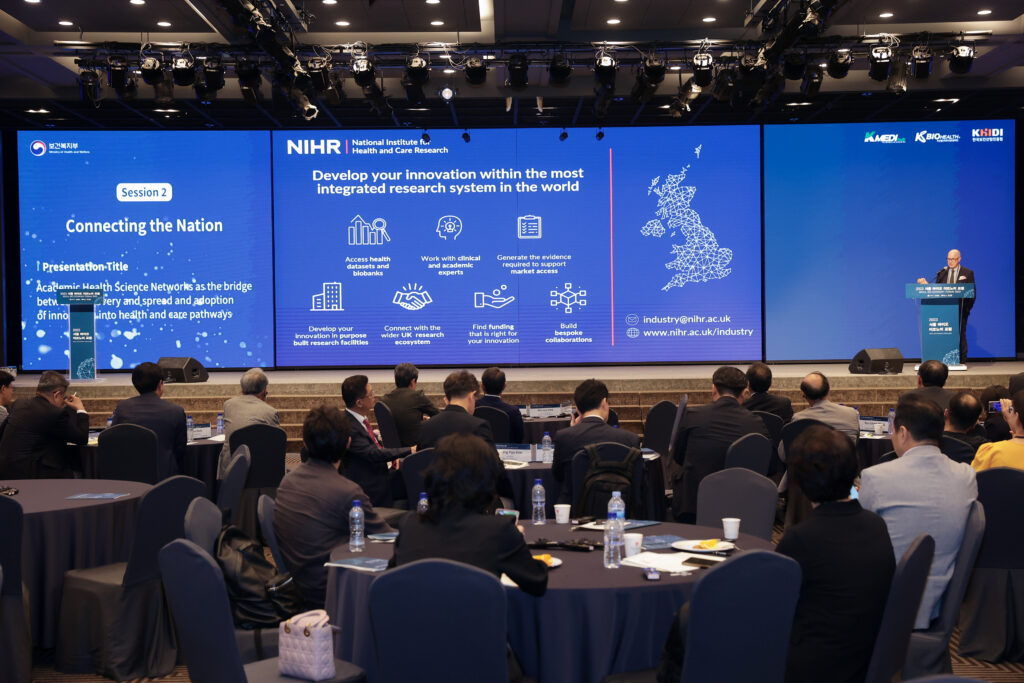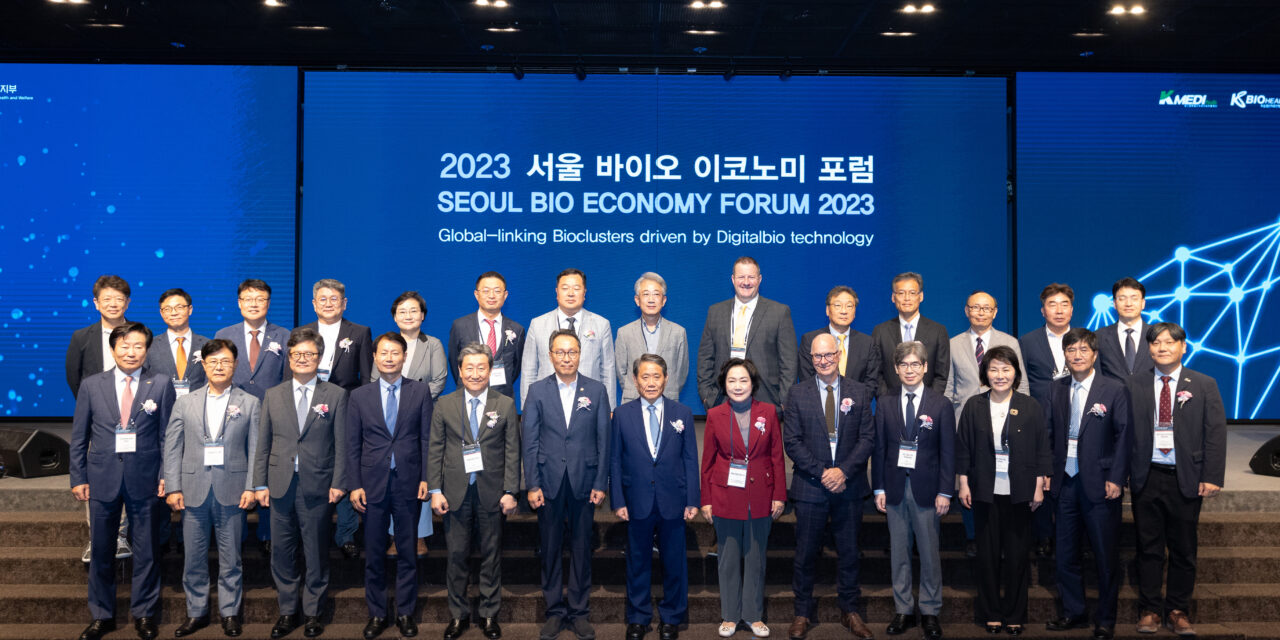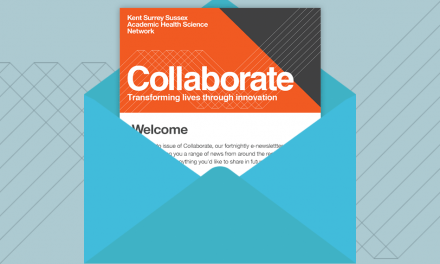Des Holden, CEO of Health Innovation KSS, recently attended the Seoul Bio Economy Forum 2023. In this blog he shares his reflections and the take-home messages from the event.
When I was invited to present at the Seoul Bio Economy Forum, I almost deleted the email as not genuine. However, the invite was rapidly chased up by colleagues from the National Institute of Health and Care Research (NIHR), who confirmed it was an in-person event taking place in the capital city of South Korea. I prepared slides for a 20-minute presentation on the national Health Innovation Network, how we are funded, how we all work locally to deliver centrally-mandated and locally-commissioned projects, and who influences the work we are asked to do, in particular, NHS England and the Innovation, Research and Life Sciences (IRLS) team, and the Department of Science, Innovation and Technology. I sent them in, signed my disclaimers and permissions to publish, and before long, I was on a plane to Seoul.

The Bio Economy Forum
The organisation of the two nights/one day I was in Seoul could not be faulted. I arrived in the evening and the next morning was taken to the conference where I met the organisers, other speakers, Government Ministers, delegates and translators. Everyone who I encountered on my journey from touchdown to take-off, via the conference and meetings, was an official, or often unofficial, ambassador for how professionalism and efficiency can give confidence and win partnerships.
The event itself dealt with a number of key themes and there were some key take-home messages…
Connecting
The theme of the morning session was connecting. Professor Toshio Fujimoto talked about Shona iPark in Japan, an industry-driven science park catalyzing open innovation. The presentation covered the challenges Shonan iPark has faced (and still faces), and what underpins its growth and success. The crucial factor was attracting anchor businesses that were prepared to support smaller companies that were subsequently drawn to the enabling conditions within the science park. Toshio had good case studies emphasizing the discovery potential of small start-ups, and the need for novel drugs to be seen as merging with other technologies such as cell and gene therapy, nucleic acid drugs, but also application devices and robotics. He drew attention to the relatively low amounts of venture capital and funding available in Japan (2% of US).
Geography
Rick Fultz, Chief Business Officer for Biocom California, a life sciences community in California, gave a complimentary presentation, again emphasizing the willingness of companies within the Californian clusters to share and work together, and the sources of investment that companies and clusters accessed. He also very honestly recognised a key factor which marks the difference between clusters that needed only a light touch approach, and those that were much harder to make work: the willingness of people to work in that geography. In a short presentation this point was returned to many times; employees and their families must be willing to, and want to, live and work in a location for the cluster to really fly.
Collaboration
My talk on connecting the country was followed by Dr Chong Jai Kim with a session called “Connecting the innovators”, which described the platform that allows clinical staff and universities working at the Asan Medical Centre (AMC) to collaborate and to set and track ideas. AMC is one of 10 research-driven hospitals and their collective output in terms of patents and intellectual property is hugely important in underpinning South Korea’s healthcare industrial, and economic ambitions. He eloquently described enablers and levers, including research and development funding and time, the built environment, and personal motivation, that allow collaborations beyond solely a focus on treating patients.
Governments
The final talk of the session, offered by Dr Ganglip Kim, Professor at the graduate School of Public Health, Yonsei University, was entitled “Connecting governments” and described the rewards, but also the challenges, of drawing from budgets from several different government departments to finance discovery, innovation and spread. To me this sounded like a familiar challenge.
Research-driven hospitals
In the afternoon I visited the Asan Medical Centre (AMC), a busy tertiary level hospital, and met with leaders from all 10 of the research-driven hospital group. This was an exciting meeting as the people in the room were looking for discussion and future collaboration, not simply slide decks delivered from a podium. For much of the discussion I needed to talk about the Research Delivery Service, NIHR and Applied Research Collaborations, a little about Academic Health Science Centres (AHSCs), funding calls and collaborations more generally. Several people during the meeting (and before the morning session got going) referenced an agreement to work together due to be signed by the UK and South Korean in November, and there was a sense in the room that the discussion was teeing up an understanding of what needed to be known about the environment and partnerships ahead of the agreement.
Several health leaders wanted specific introductions to clinical academics and to custodians of datasets they believed offered joint opportunities. For instance, with a stated focus on cell and genomic medicine/intervention, an introduction to the 100,000 Genomes Project was unsurprising. But what was a bit surprising was the lack of apparent competition between hospitals, with a sense that their mission was to succeed together, with complimentary areas of interest.

My key reflections
South Korea has a huge ambition for its biotechnology and health/life science offering but regards the partnerships it needs to make as international and ultimately global. It was a pleasure to speak in the morning session and sit on the panel for the main audience, but I have always preferred the seminar/discussion format for knowledge exchange. The afternoon spent with the 10 research-driven hospital leaders really made me think, and there is so much more now I would like to ask. Is there a route for other hospitals to be designated and funded similarly, or is 10 their optimum number? All have partnerships with universities, but for those we discussed the partnership was with many universities, rather than one or two located nearby. What are the lessons, if any, for our AHSCs? And importantly for me, is there also a message for hospitals with research ambitions and credentials, that do not have local complimentary research interest or capacity? How many of the conditions deemed necessary at the AMC can be duplicated in a teaching hospital, or in a District general hospital as an early decleration of intent? Which of an ICBs accountabilities for research, innovation and economic growth could be met or progressed, by supporting this agenda – particularly if the hospital, and the wider health and care delivery structures, are thought of as an anchor, or enabling partner, for the people who live and work there?
What I hope for the future
I hope that I can make some productive introductions that the South Korean health leaders have asked for. I hope I will take the thinking and belief I saw into the work I do both with researchers and innovators, and also with health and care providers. Our value as members of a national network in health and care is the knowledge we have and the connections we make, with an increasing focus on outcome and impact. My South Korean experience gave me some new insights and underlined some I already had, and I am very grateful to be given the chance to visit, talk and listen, and think about the future with a slightly different perspective. I hope this benefits the people and systems of Kent, Surrey and Sussex, and more widely across the Health Innovation Network footprint.





